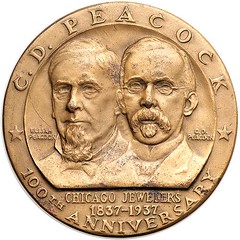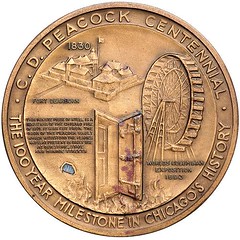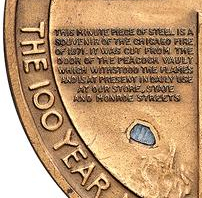
PREV ARTICLE
NEXT ARTICLE
FULL ISSUE
PREV FULL ISSUE
VOCABULARY TERM: IMPRESSED DESIGNDick Johnson submitted this entry from his Encyclopedia of Coin and Medal Terminology. Thanks. I added the images of the C. D. Peacock medal, found on the Goldberg's site. -Editor  
https://www.goldbergcoins.com/view-auctions/catalog/id/33/lot/69075 Impressed Design. An added piece of metal or other very hard substance which by intent is laid on the surface of a blank or partially struck medal and is pushed into its surface by the blow of the press and the striking of the dies. Impressed objects are much like an inlay – appearing below the surface – by placing it there before the final blow (this is easy to do with open face dies, but difficult in coining). Impressed objects are subject to flaking off, so care must be taken in their handling. When such an object is not inlaid by design it is an anomaly called impressed error (see next entry). The first evidence of this occurred in 1692. Trial halfpennies and farthings of William and Mary were struck with impressed metal shapes. A halfpenny exists with a mullet-shaped or circular tin center impressed in a copper coin; or an 8-pointed star in copper impressed in a tin coin. The farthings had a ring of brass impressed in a copper coin. According to C. Wilson Peck, of the British Museum, the reason is unknown why these few trials were made. A similar ancient technique was used in Etheopia as early as AD 380, and in China for a special 5,000 ch'ien coin in AD 7
References: NC7 {1960} Peck, pp 158-9. Looking for the meaning of a numismatic word, or the description of a term? Try the Newman Numismatic Portal's Numismatic Dictionary at: https://nnp.wustl.edu/library/dictionary Or if you would like a printed copy of the complete Encyclopedia, it is available. There are 1,854 terms, on 678 pages, in The Encyclopedia of Coin and Medal Technology. Even running two a week would require more than 19 years to publish them all. If you would like an advance draft of this vital reference work it may be obtained from the author for your check of $50 sent postpaid. Dick Johnson, 139 Thompson Drive, Torrington, CT 06790. Wayne Homren, Editor The Numismatic Bibliomania Society is a non-profit organization promoting numismatic literature. See our web site at coinbooks.org. To submit items for publication in The E-Sylum, write to the Editor at this address: whomren@gmail.com To subscribe go to: https://my.binhost.com/lists/listinfo/esylum All Rights Reserved. NBS Home Page Contact the NBS webmaster 
|
